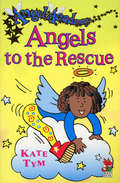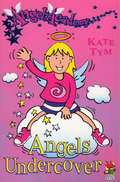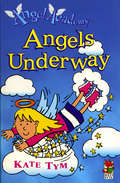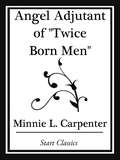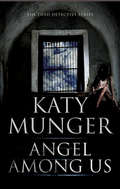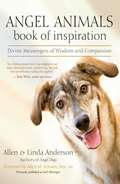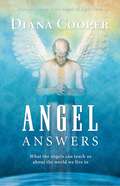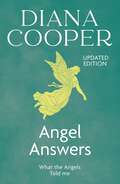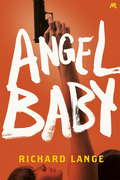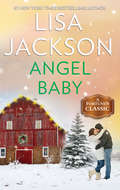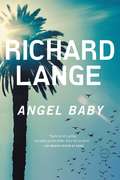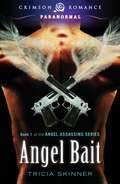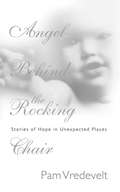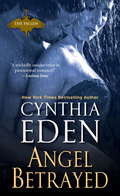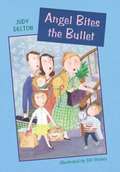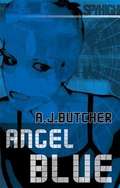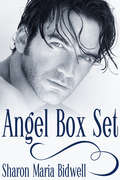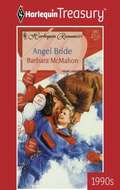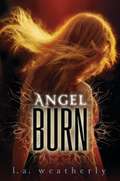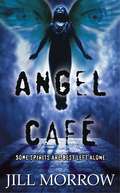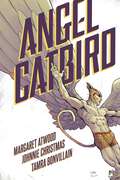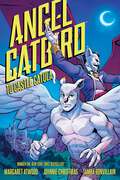- Table View
- List View
Angel Academy - Angels To The Rescue
by Kate TymThe angels are on a mission 'down below' to beat three school bullies. Will they be able to turn the bad kids into nice people that the other kids actually like? Their newly acquired skill of voice-throwing seems an ideal way to tame the teasers . . .
Angel Academy - Angels Undercover
by Kate TymMo, Colin and Ronnie go undercover to catch a crafty blackmailer at work in the Academy. But when things go wrong, and Colin is charged with the crime, Mo and Ronnie must work together to prove his innocence and unveil the identity of the real blackmailing baddie.
Angel Academy - Angels Underway
by Kate TymTHE FIRST CHALLENGE It's assignment time at Angel Academy, and for aspiring angels Mo and Colin, it's their chance to prove themselves. Colin's cool about the whole thing, which really annoys Mo - she's just GOT to do THE best project the Academy has ever seen. But when she dumps poor Colin and goes it alone, things don't QUITE go according to plan. In the end, Colin ends up with the better project and Mo learns a very important lesson - the importance of friendship and working together.
Angel Adjutant of "Twice Born Men" (Start Classics)
by Minnie L. Carpenter"The Salvation Army has been happy in its Women Officers. The lessons of experience undoubtedly teach us that they are fully qualified for all the work of the ministry of Christ."
Angel Among Us (The Dead Detective Mysteries #4)
by Katy MungerIn the fourth compelling ‘Dead Detective’ mystery, Kevin Fahey uncovers disturbing secrets when a schoolteacher disappears.—Following his untimely death, former cop Kevin Fahey roams the streets of his small Delaware town seeking redemption in other people’s lives. He knows secrets the living do not know. When beautiful, pregnant pre-school teacher Arcelia Gallagher disappears, Fahey knows that she is hiding a violent past, and when the police investigation leads to Delmonte House, Fahey realizes that evil and fear have stalked the house before. Someone is lurking within its halls, their motives are unknown. Can Arcelia be found in time?
Angel Animals Book of Inspiration
by Linda Anderson Allen AndersonSome of these extraordinary true stories will make you smile and others will bring tears to your eyes, but each one will open your heart to new revelations of love in its many forms and shapes. Dogs, cats, horses, ferrets, birds, rabbits, snakes, dolphins, llamas -- the animals in this book reveal compassion, teach hope and forgiveness, or serve as a barometer to measure feelings. After reading just one of these stories, you will observe the animals in your own path with new eyes and find yourself awakening to deeper, and often startling, spiritual insights.
Angel Animals: Divine Messengers of Miracles
by Linda Anderson Allen AndersonThe animals who hold a cherished place in our hearts and homes offer inspiring lessons of patience, trust, compassion, healing, and love. The extraordinary true stories in this revised and updated edition of Angel Animals celebrate the spiritual truths we learn from animals, and remind us that miracles do happen. These surprising, heartwarming stories — about dogs, cats, horses, rabbits, raccoons, bears, birds, dolphins, deer, insects, and more — help us rise to life's challenges, find comfort in the face of loss, witness the hand of the Divine, and recognize the interconnectedness of all living things.
Angel Answers
by Diana CooperAngels provide outlooks that can help resolve any human dilemma, whether social, political, historical, personal, sexual, or spiritual, and their enlightened approaches are recorded in this insightful and uplifting spiritual guide. True and inspiring personal stories prove that no problem is too difficult when angels are consulted, and numerous exercises and meditations are included to make listening to and understanding angels easier. These simple, clear, and compassionate answers are presented as a way of resolving trying issues and finding peace.
Angel Answers
by Diana CooperIn ANGEL INSPIRATION, Diana showed us how to tap into the awesome power of the angels. In ANGEL ANSWERS she brings us lessons from the angels advising us how we should live our lives in the bewildering modern world. From relationships with children or friends to illnesses, from understanding why some people become addicted to drugs or alcohol and how to alleviate their problems, to strategies for bringing about greater equality in the world, Diana covers a vast array of the biggest questions faced by humanity.Full of the wisdom and inspiration that she has gleaned over years of angel work, ANGEL ANSWERS is the book Diana's army of fans has been waiting for and is also the perfect introduction to her writing.
Angel Answers
by Diana CooperIn ANGEL INSPIRATION, Diana showed us how to tap into the awesome power of the angels. In ANGEL ANSWERS she brings us lessons from the angels advising us how we should live our lives in the bewildering modern world. From relationships with children or friends to illnesses, from understanding why some people become addicted to drugs or alcohol and how to alleviate their problems, to strategies for bringing about greater equality in the world, Diana covers a vast array of the biggest questions faced by humanity.Full of the wisdom and inspiration that she has gleaned over years of angel work, ANGEL ANSWERS is the book Diana's army of fans has been waiting for and is also the perfect introduction to her writing.
Angel Baby
by Richard LangeWINNER OF THE 2014 HAMMETT PRIZELuz has made a lot of mistakes, but she's trying to make up for it. She's worked it all out. She's quit the drugs. She's only taking the clothes on her back, a gun and the money in her husband's safe. She's going to find her daughter and no one's going to stop her. The corpses in the hallway weren't part of the plan. In this powerful story of revenge and redemption, one woman's desperate break for freedom will change the lives of criminals and cops on both sides of the border.
Angel Baby: A Classic Romance Novella
by Lisa JacksonA fan-favorite from #1 New York Times bestselling author Lisa Jackson, originally published in A Fortune’s Children Christmas in 1998. Chase Fortune has one year to turn around a rundown ranch to inherit it from his great-aunt. But his careful plans go awry when he rescues his beautiful neighbor, Lesley Bastian, from a blizzard and helps her deliver her baby. Lesley isn’t the staying type—she wants to get back on her feet as soon as possible so she can manage her own ranch. But fate and weather conspire to keep them together, and soon Chase must face the terrible choice between his home and his heart. Originally published in 1998.
Angel Baby: A Novel
by Richard LangeA woman goes on the run in this intense and cinematic thriller by an award-winning writer. To escape the awful life she has descended into, Luz plans carefully. She takes only the clothes on her back, a Colt .45, and all the money in her husband's safe. The corpses in the hallway weren't part of her plan.Luz needs to find the daughter she left behind years earlier, but she knows she may die trying. Her husband is El Principe, a key player in a high-powered drug cartel, a business he runs with the same violence he has used to keep Luz his perfect, obedient wife.With the pace and relentless force of a Scorsese film, ANGEL BABY is the newest masterpiece from one of the most ambitious and talented crime novelists at work today.
Angel Bait
by Tricia SkinnerSaved by the angel sent to kill them, four half-angel boys are trained and employed as Heaven's assassins. Jarrid and his nephilim brothers are raised as members of The Eternal Order, and must enforce Heaven's laws by hunting down those who defy the Directorate.His only shot at freedom is Ascension, but his employers won't permit the ancient ritual. Then Jarrid learns a Renegade angel is in Detroit. Such a high-level take-down is the answer to his prayers - all the leverage he needs to Ascend.For freedom, Jarrid is willing to do anything to lure his elusive enemy out of hiding.Even use an innocent woman as bait.News reporter Ionie Gifford has no clue an angel outlaw wants her dead. She agrees to help Jarrid, the enigmatic nephilim with penetrating silver eyes and a worship-worthy body, but only because he accepts her terms. He's her all-access pass into the city's supernatural underworld where she hopes to locate her mother's killer.Blindsided by Ionie's beauty and tenacity, Jarrid soon finds the eternity-old glacier around his heart thawing. With duty and desire at war within him, he's forced to make a choice - either save Ionie from the trap he snared and stay chained to Heaven, or allow her to become collateral damage.Sensuality Level: Sensual
Angel Behind the Rocking Chair
by Pam VredeveltAfter the loss of her first baby and the birth of a fourth child with Down Syndrome, Pam Vredevelt felt that she had fallen from God's grasp. As she was soon to discover, however, God was just beginning to hold her tight and lead the way out of her endless pit of despair. With humor and touching insight, Pam unveils her struggle to emerge from darkness into the light in this paperback release of her popular work. Many have been touched by the same anguish; Pam shares their stories and how the supernatural touch of God sustained them through the darkest days of life.From the Trade Paperback edition.
Angel Betrayed
by Cynthia EdenA Little Bit Of Angel LustSammael--call him Sam--was an angel once. An angel of Death. But the dispassionate, watch-from-above thing just wasn't working for him when it meant watching evil torture innocent souls day in and day out. It might have cost him his wings, but these days he gets to apply the direct method on the bad guys. Problem is, what's making his life difficult is a bad girl. . .Seline O'Shaw needs protection, and with the hounds of hell on her tail, she's not going to quibble too hard about where she gets it. Sam's virtue is questionable, but he's smoking hot, massively powerful, and owes her a favor. So what if she's getting a little case of angel lust? There are some damn deadly sins after her hide. . .
Angel Bites the Bullet
by Judy Delton[From the inside dust jacket flap:] "What does a ten-year-old girl do when her mother's best friend moves into her room? Angel wants her bedroom back, and that means Alice must go! Angel springs into action, and comedy ensues as Angel and her friend Edna try and try again to find a love match for Alice. Along the way, Angel learns that more changes are in store. . . and that she can handle them much better than she thought. From the first page to the last, readers will be hooked on this funny, fast-paced story about an especially endearing heroine." Angel has a way of getting into funny situations as she gets through confusing, difficult experiences on the way to growing up. Another book about Angel called Angel's Mother's Boyfriend is already in the Bookshare collection with more books in this series on the way including Back Yard Angel, Angel In Charge, Angel's Mother's Wedding, Angel's Mother's Baby and Angel Spreads Her Wings. They are coming so fast that by the time you read this they will probably be ready for you!
Angel Blue (Spy High Series 2, Book #2)
by A. J. ButcherLori Angel is a graduate of the Deveraux College, the highly secret school for teenage spies. Until now she's been posted on the coast, doing a whole lot of surfing and partying. But then a fellow graduate turns up at her apartment. Dead. Stashed in his rucksack are a series of clues that will lead Lori into the most dangerous situation of her life. And into conflict with a secret society, every member of which is supposed to be dead. Lori Angel is the new spy novel from the author of the brilliant Edward Red. It's an everyday story of rad-surfing, cool parties and body-swapping megalomaniacs trying to destroy humanity.
Angel Box Set
by Sharon Maria BidwellSharon Maria Bidwell’s best-selling gay romance trilogy is now available in a box set. From falling in love to finding forever, join Dean and Jay on the way to their happy ever after! Contains the stories:Snow Angel: Dean likes women, but not nearly as much as he likes himself. Little does he know his friend Jay is in love with him, always has been, always will be, but he’s about to find out. If Dean isn’t careful, he might lose the one person who can take him just as he is, ego included. Angel Heart: There’s a reason Dean calls his lover Angel, but Jay’s thoughts are far from angelic. He must stop his sister interfering in their relationship, and ask if Dean’s remembered to pack the strawberry lube for the weekend.Christmas Angel: True love's path seldom runs smooth. Dean Chapman built his life and reputation around being a womaniser. Until he fell in love with a man. Three years with his boyfriend, Jay, have upended the identity of which he was always so sure. To give the man he loves the commitment he deserves, Dean must lay his heart open to a future of possibilities, or risk losing everything.
Angel Boy
by Bernard AshleyThe holidays lie heavy on young Leonard Boameh. His school friends live far away from his home town of Accra, his nana is no fun, and his dad -- who's great -- is away working most of the time. So Leonard decides to run away for a few hours, and when Nana isn't looking he takes the tro-tro bus to Elmina, a historic European fort built to imprison West African slaves shipped off to America. There are lots of rough kids begging there, and before Leonard knows what's happening, he is kidnapped by the meanest gang of all, who plan to use his angel-face to fleece the tourists. Leonard is now a slave, trying to escape from a living nightmare.
Angel Bride
by Barbara McmahonHit the altar trail with Barbara McMahon's WESTERN WEDDINGS! Jake Morgan is back in town! Two years ago Angel had loved Jake, and she'd even started to believe he cared for her. But then without so much as a word he'd dumped her. She'd had to pick up the pieces of her life and start over. Now with Jake back, Angel's life is in chaos and, on top of it all, her home and office have been broken into. Jake decides to take her off to the mountains until the perpetrator is caught. But he's no angel. And, while he might protect her person, heaven knows what he'll do to her heart! SIMPLY THE BEST. Authors you'll treasure, books you'll want to keep!
Angel Burn
by L. A. WeatherlyIn a world where angels are not benign celestial creatures, but fierce stalkers whose irresistible force allows them to feed off humans, draining them of their vitality, a ruthless teenaged assassin of angels falls in love with a half-angel, half-human girl, with devastating consequences.
Angel Cafe
by Jill MorrowTHE TRUTH LIES ON THE OTHER SIDE... South Baltimore's Angel Café is a trendy new eatery where patrons can enjoy exotic tea, aromatic coffee, and the psychic readings of clairvoyant Tia Melody. The star and main attraction of the restaurant, Tia claims to channel an otherworldly guide, Valentine, and somehow knows all there is to know about her expanding list of patrons. Kat Valenti is a workaholic attorney still coming to grips with the death of her fiancé, Peter, who died two years ago. Although drawn to the Angel Café, she is skeptical of Tia's readings -- until her late fiancé 'contacts' her to shed new light on how he died. Kat's wariness only grows as more clues turn up about Peter's death -- and all of them lead back to the Angel Café. Tia Melody is no simple fortune-teller, and Valentine is no benevolent spirit. Valentine's true power may be almost limitless -- and he doesn't want to tell the future anymore... He wants Kat.
Angel Catbird Volume 1 (Angel Catbird #1)
by Margaret AtwoodThe Booker Prize-winning author of The Handmaid&’s Tale writes her first graphic novel, a cat-centric all-ages New York Times bestselling adventure.On a dark night, young genetic engineer Strig Feleedus is accidentally mutated by his own experiment and merges with the DNA of a cat and an owl. What follows is a humorous, action-driven, pulp-inspired superhero adventure-- with a lot of cat puns.Lauded novelist Margaret Atwood and acclaimed artist Johnnie Christmas collaborate on one of the most highly anticipated comic book and literary events of the year!Published in over thirty-five countries, Margaret Atwood is one of the most important living writers of our day and is the author of more than forty books of fiction, poetry, and critical essays. Her work has won the Man Booker Prize, the Giller Prize, Premio Mondello, and more. Angel Catbird is her first graphic novel series.Atwood's The Blind Assassin was named one of Time magazine's 100 best English-language novels published since 1923 and her recent MaddAddam Trilogy is currently being adapted into an HBO television show by Darren Aronofsky
Angel Catbird Volume 2: To Castle Catula (Angel Catbird #2)
by Margaret AtwoodThe cat-centric adventure continues, in the all-ages follow-up to The Handmaid&’s Tale author Margaret Atwood's debut graphic novel. Genetic engineer Strig Feleedus, also known as Angel Catbird, and his band of half-cats head to Castle Catula to seek allies as the war between cats and rats escalates.Margaret Atwood, the respected, worldwide best-selling novelist, and acclaimed artist Johnnie Christmas continue their action-packed adventure!Atwood's The Blind Assassin was named one of Time magazine's 100 best English-language novels published since 1923 and her recent MaddAddam Trilogy is currently being adapted into an HBO television show by Darren AronofskyPublished in over thirty-five countries, Margaret Atwood is one of the most important living writers of our day and is the author of more than forty books of fiction, poetry, and critical essays. Her work has won the Man Booker Prize, the Giller Prize, Premio Mondello, and more. Angel Catbird is her first graphic novel series.
